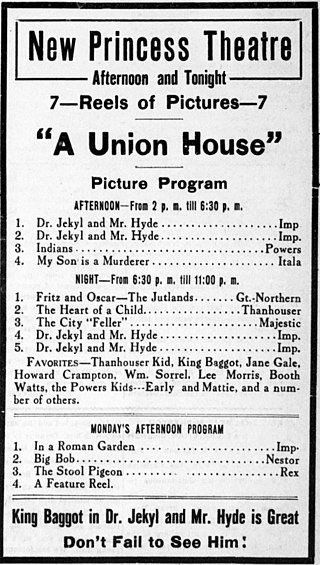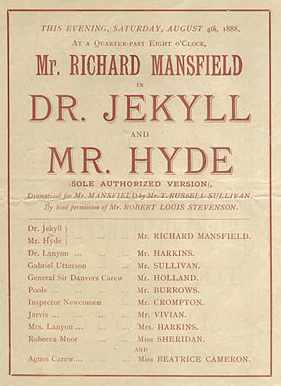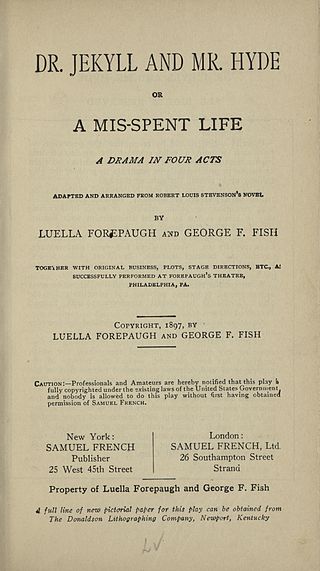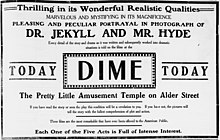The year 1920 in film involved some significant events.
The year 1914 in film involved some significant events, including the debut of Cecil B. DeMille as a director.
1913 was a particularly fruitful year for film as an art form, and is often cited one of the years in the decade which contributed to the medium the most, along with 1917. The year was one where filmmakers of several countries made great artistic advancements, producing notable pioneering masterpieces such as The Student of Prague, Suspense, Atlantis, Raja Harischandra, Juve contre Fantomas, Quo Vadis?, Ingeborg Holm, The Mothering Heart, Ma l’amor mio non muore!, L’enfant de Paris and Twilight of a Woman's Soul.
The year 1912 in film involved some significant events.
The year 1911 in film involved some significant events.
The year 1910 in film involved some significant events.
The year 1909 in film involved some significant events.
The year 1908 in film involved some significant events.
The year 1903 in film involved many significant events in cinema.
Dr. Jekyll and Mr. Hyde, or Strange Case of Dr Jekyll and Mr Hyde, is a 1886 novella by Robert Louis Stevenson.

Dr. Jekyll and Mr. Hyde is a 1920 American silent horror film produced by Famous Players–Lasky and released through Paramount/Artcraft. The film, which stars John Barrymore, is an adaptation of the 1886 novella Strange Case of Dr Jekyll and Mr Hyde by Robert Louis Stevenson. John S. Robertson directed the production, and Clara Beranger wrote the screenplay, based on the 1887 stage play by Thomas Russell Sullivan that in turn was based on the novel.

The Two Faces of Dr. Jekyll is a 1960 British horror film directed by Terence Fisher and starring Paul Massie, Dawn Addams, Christopher Lee and David Kossoff. It was produced by Michael Carreras for Hammer Film Productions. The screenplay was by Wolf Mankowitz, based on the 1886 novella Strange Case of Dr Jekyll and Mr Hyde by Robert Louis Stevenson.

Dr. Jekyll and Mr. Hyde is a 1912 horror film based on both Robert Louis Stevenson's novella Strange Case of Dr Jekyll and Mr Hyde (1886) and on the 1887 play version written by Thomas Russell Sullivan. Directed by Lucius Henderson, the film stars actor James Cruze in the dual role of Dr. Jekyll and Mr. Hyde, and co-starred his real life wife Marguerite Snow as well.

Dr. Jekyll and Mr. Hyde is a 1920 horror film directed and written by J. Charles Haydon, starring Sheldon Lewis, based on the 1886 novel Strange Case of Dr. Jekyll and Mr. Hyde by Robert Louis Stevenson. The Sheldon Lewis version was somewhat overshadowed by the 1920 Paramount Pictures version starring John Barrymore, which had been released just the month before.

Dr. Jekyll and Mr. Hyde is a 1913 horror film based on Robert Louis Stevenson's 1886 gothic novella Strange Case of Dr. Jekyll and Mr. Hyde. Directed by Herbert Brenon for producer Carl Laemmle's company IMP, the production stars King Baggot in the dual role of Jekyll and Hyde. The film was re-released in the United States in August 1927.

Strange Case of Dr Jekyll and Mr Hyde is an 1886 novella written by the Scottish author Robert Louis Stevenson. It is about a London lawyer, Gabriel John Utterson, who investigates strange occurrences between his old friend, Dr. Henry Jekyll and the misanthropic Mr. Hyde. In a twist ending, it is revealed that Jekyll and Hyde were the same person, and that Jekyll had regularly transformed himself into Hyde by drinking a serum.

Carl Alwin Heinrich Neuß was a German film director and actor, noted for playing Sherlock Holmes in a series of silent films during the 1910s. He also played the dual role of Jekyll and Hyde in the 1910 Danish silent film version of Dr. Jekyll and Mr. Hyde, directed by August Blom. He played Jekyll and Hyde again in the 1914 German silent film Ein Seltsamer Fall, scripted by Richard Oswald.

Dr. Jekyll and Mr. Hyde is a four-act play written by Thomas Russell Sullivan in collaboration with the actor Richard Mansfield. It is an adaptation of Strange Case of Dr Jekyll and Mr Hyde, an 1886 novella by the Scottish author Robert Louis Stevenson. The story focuses on the respected London doctor Henry Jekyll and his involvement with Edward Hyde, a loathsome criminal. After Hyde murders the father of Jekyll's fiancée, Jekyll's friends discover that he and Jekyll are the same person; Jekyll has developed a potion that allows him to transform himself into Hyde and back again. When he runs out of the potion, he is trapped as Hyde and commits suicide before he can be arrested.

Dr. Jekyll and Mr. Hyde, Or a Mis-Spent Life is a four-act play written in 1897 by Luella Forepaugh and George F. Fish. It is an adaptation of Strange Case of Dr Jekyll and Mr Hyde, an 1886 novella written by the Scottish author Robert Louis Stevenson. The story focuses on Henry Jekyll, a respected London doctor, and his involvement with Edward Hyde, a loathsome criminal. After Hyde murders a vicar, Jekyll's friends suspect he is helping the killer, but the truth is that Jekyll and Hyde are the same person. Jekyll has developed a potion that allows him to transform himself into Hyde and back again. When he runs out of the potion, he is trapped in his Hyde form and commits suicide.









